Table of Contents
Time allowed: 3 hours Maximum marks: 90
General Instructions:
- The Question Paper comprises two Sections, A and B. You are to attempt both the Sections.
- All questions are compulsory.
- There is no choice in any of the questions.
- All questions of Section-A and all questions of Section B are to be attempted separately.
- Question numbers 1 to 3 in Section A are one mark questions. These are to be answered in one word or in one sentence.
- Question numbers 4 to 6 in Section A are two marks questions. These are to be answered in about 30 words each.
- Question numbers 7 to 18 in Section A are three marks questions. These are to be answered in about 56 words each.
- Question numbers 19 to 24 in Section A are five marks questions, these are to be answered in about 70 words each.
- Question numbers 25 to 33 in Section B are multiple choice questions based on practical skills. Each question is a one mark question. You are to select one most appropriate response out of the four provided to you.
- Question numbers 34 to 36 in Section B are two marks questions based on practical skills. These are to be answered in brief.
| Related Link CBSE Class 10 Science PYQs |
| CBSE Class 10 Science Question Paper 2022 |
| CBSE Class 10 Science Question Paper 2021 |
| CBSE Class 10 Science Question Paper 2020 |
| CBSE Class 10 Science Question Paper 2019 |
| CBSE Class 10 Science Question Paper 2018 |
| CBSE Class 10 Science Question Paper 2014 |
| CBSE Class 10 Science Question Paper 2011 |
SET I
SECTION A
Question.1. List any two properties of the elements belonging to the first group of the modern periodic table.
Answer. Elements of first group have one valence electron each in their atoms.
All the elements of group 1 have the same valency of 1.
Question.2. What is gene?
Answer. A gene is a unit of DNA on a chromosome which governs the synthesis of one protein that controls a specific character of an organism. Thus genes are actually units of heredity which transfer characteristics from parents to their off springs during reproduction.
Question.3. Give one example each from your daily life where the domestic waste can be effectively reused and recycled.
Answer. We should collect the used and discarded items of plastic, paper, glass and metals and send them for recycling to get these items again for use.
Paper envelopes can be reversed inside out and used again.
Question.4. What is the main difference between sperms and eggs of humans? Write the importance of this difference.
Answer. The main difference lies in the difference in the sex chromosome of sperm (male gamete) and egg (female gamete). The main difference between sperms and eggs of humans is that half of the sperms of a male (father) will have X chromosomes and the other half will have Y chromosomes. All the eggs of female (mother) will have only X chromosomes. Importance. If the father contributes X sex chromosome, at fertilisation through his sperm, the baby bom will be a girl. On the other hand, if the father contributes a Y sex chromosome at fertilisation through his sperm, then the baby born will be a boy. Therefore the sperm determines the sex of the child.
Question.5. List two possible ways in which a concave mirror can produce a magnified image of an 1 object placed in front of it. State the difference, if any, between these two images.
Answer. Case 1. Concave mirror can produce an erect, magnified, virtual image when the object is placed between pole and focus of the mirror
Case 2. Concave mirror also produces an inverted, magnified, real image when the object is placed between the focus and the centre of curvature.

Question.6. What are decomposers? List two important roles they play in the environment.
Answer.
- Decomposers are micro organisms that break down complex organic substances (dead remains and waste products of organisms) into simpler inorganic substances that go into the soil and are used up once more by the plants.
- Decomposers play an important role in the cycling of materials in the biosphere.
- By decomposing dead bodies of plants and animals they help in cleansing the environment. Example, Bacteria and fungi are examples of decomposers.
Question.7. What are homologous series of carbon compounds? Write the molecular formula of two consecutive members of homologous series of aldehydes. State which part of these compounds determines their (i) physical and (ii) chemical properties.
Answer. Homologous series. A series of carbon compounds in which the same functional group substitutes for hydrogen on a carbon chain is called a homologous series. There is a difference of -CH2 in the molecular formulae of two nearest compounds of a homologous series. Each such seiies has same general molecular formula and has a general scientific name. There is a difference of 14 g (unified mass) in the molecular masses of two nearest compounds of a series.
Members of homologous series of aldehydes:
H – CHO Methanal
CH3– CHO Ethanal
C2H5—CHO Propanal
(i) The carbon-chain attached to aldehyde group, i.e., (H —, CH3 —, C2H5 —) determine the physical properties.
(ii) The functional group attached to all aldehydes ( — CHO) determines the chemical properties.
Question.8. A carboxylic acid (molecular formal C2H402) reacts with an alcohol in the presence of an acid catalyst to form a compound ‘X. The alcohol on oxidation with alkaline KMnO4 followed by acidification gives the same cairboxylic acid C2H402. Write the name and structure of (i) carboxylic acid, (ii) alcohol and (iii) the compound ‘X.
Answer. See Q. 8, 2013 (I Outside Delhi).
Question.9. The electrons in the atoms of four elements A, B, C and D are distributed in three shells having 1, 3, 5 and 7 electrons in the outermost shell respectively. State the period in which these elements can be placed in the modern periodic table. Write the electronic configuration of the atoms of A and D and the molecular formula of the compound formed when A and D combine.
Answer.

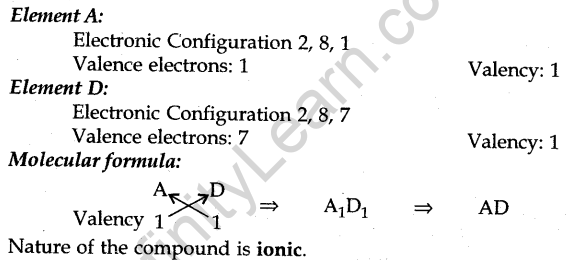
Question.10. Study the following table in which positions of six elements A, B, C, D, E and F are shown as they are in the modern periodic table:

On the basis of the above table, answer the following questions:
(i) Name the element which forms only covalent compounds.
(ii) Name the element which is a metal with valency three.
(in) Name the element which is a non-metal with valency three.
(iv) Out of D and E, which is bigger in size and why?
(v) Write the common name for the family to which the elements C and F belong.
Answer. (i) E (ii) D (iii) B
(iv) D is bigger in size because as we move from left to right in a period, the size of the atom decreases as positive charge increases but the number of shells remains the same. Thus the electrons are pulled in more close to the nucleus.
(v) Noble gases
Question.11. Explain the process of regeneration in Planaria. How is this process different from reproduction?
Answer. Process of regeneration. The process of getting back a full organism from its body parts is called regeneration. The simple animals like Hydra and planaria show regeneration. Diagram. See Q. 24(b), 2011 (I Delhi).
Regeneration is different from reproduction. Regeneration of an organism from its cut body part occurs by the process of growth and development.
Question.12. What is placenta? State its function in human female:
Answer. See Q. 13, 2013 (III Outside Delhi).
Question.13. With the help of suitable examples, explain why certain traits cannot be passed on to the next generation. What are such traits called?
Answer. A trait of an organism which develops in response to the environment and brought in the non-reproductive tissues can not be passed on to the DNA of the germ cells. Such traits are called acquired traits. An individual cannot pass these traits to its progeny as these traits cannot be passed on to the DNA of the germ cell.
Example:
- If a beetle does not get sufficient food for a considerable time, its weight will reduce due to starvation. The low weight is an acquired trait.
- Cut tail of a mouse.
Question.14. “A trait may be inherited, but may not be expressed.” Justify this statement with the help of a suitable example.
Answer.
- Mendel crossed pure-bred tall pea plants with pure-bred dwarf pea plants and found that only tall pea plants were produced in the generation.
- Mendel then crossed the tall pea plants of generation and found that tall plants and dwarf plants were obtained in the F2 generation in the ratio of 3 :1.
- This experiment shows that the traits of dwarfness had rot been lost but it was merely concealed in the F1 generation.
Thus “A trait may be inherited, but may not be expressed.”
Question.15. A student wants to project the image of a candle flame on a screen 60 cm in front of a mirror by keeping the flame at a distance of 15 cm from its pole.
(i) Write the type of mirror he should use.
(ii) Find the liner magnification of the image produced.
(iii) What is the distance between the object and its image?
(iv) Draw a ray diagram to show the image formation in this case.
Answer.
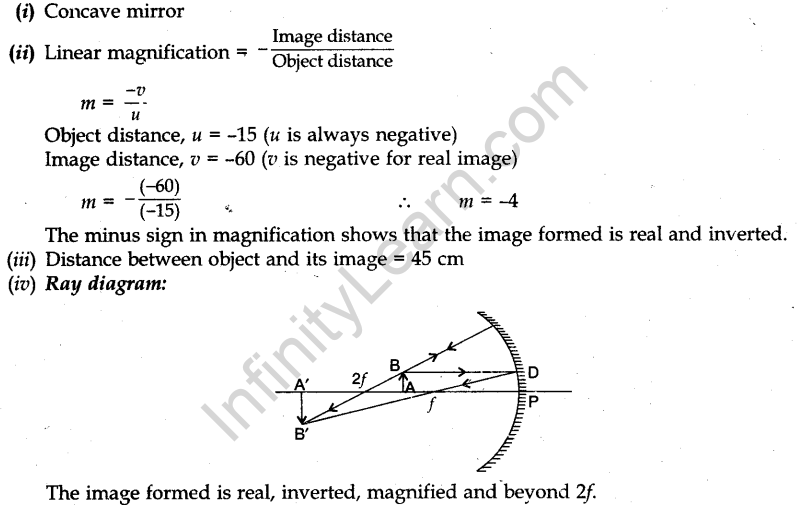
Question.16. Draw a ray diagram to show the path of the refracted ray in each of the following cases: A ray of light incident on a concave lens is
(i) passing through its optical centre.
(ii) parallel to its principal axis.
(iii) directed towards its principal focus.
Answer. (i) A ray of light passing through optical centre of a concave lens. An incident ray passing through the optical centre of a lens (concave or convex) goes straight after refraction.
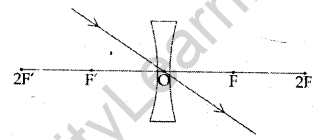
(ii) Light ray parallel to principal axis
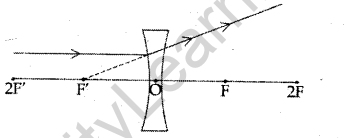
(iii) A ray of light directed towards principal focus
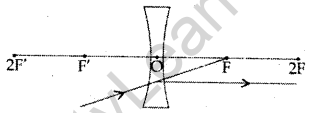
Question.17. A narrow beam PQ of white light is passing through a glass prism ABC as shows in the diagram.
(i) Write the name and cause of the phenomenon observed.
(ii) Where else in nature is this phenomenon observed?
(iii) Based on this observation, state the conclusion which can be drawn about the constituents of white light.
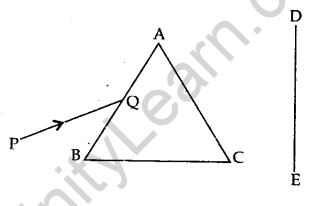
Answer. (i) The phenomenon of splitting of white light into seven colours on passing through a glass-prism is called dispersion of light. The dispersion of white light occurs because colours of white light travel at different speeds through the glass prism.
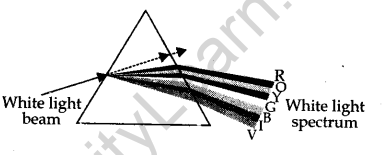
(ii) Formation of rainbow is an example of dispersion of white light in nature.
(iii) The formation of spectrum of seven colours shows that white light is made up of lights of seven different colours mixed together. That is, white light is a mixture of seven colours (or seven coloured lights), t.e., red, orange, yellow, green, blue, indigo and violet.
Question.18. “Energy flow in a food chain is unidirectional.” Justify this statement. Explain how the pesticides enter a food chain and subsequently get into our body.
Answer. “Energy flow in a food chain is unidirectional.” In the ecosystem energy flows from one trophic level to the next trophic level of the food chain. Energy flows from producers i.e., green plants to the consumers. It does not flow from the last consumer to its previous consumer and so on. Thus the energy does not flow back from consumers to the producers. So we say that flow of energy in an ecosystem is unidirectional. Entry of pesticides in a food chain. Some harmful chemicals like pesticides, when absorbed by the plants through soil and water, get transferred from first trophic to the last trophic level of the food chain. As these chemicals are non-degradable, their concentration in the bodies of living organisms at each trophic level progressively increases. Their increase in the concentration of harmful chemicals in the body of living organisms at each trophic level of a food chain is called biological magnification. The level of concentration of chemicals is maximum for human beings as they are at the highest trophic level.
Question.19. Elements forming ionic compounds attain noble gas configuration by either gaining or losing electrons from their outermost shells. Give reason to explain why carbon cannot attain noble gas configuration in this manner to form its compounds. Name the type of bonds formed in ionic compounds and in the compounds formed by carbon. Also give reason why carbon compounds are generally poor conductors of electricity.
Answer. Carbon mainly forms covalent bonds because carbon atoms have 4 electrons in their outermost shell. So it .needs to gain or lose electrons to attain noble gas configuration.
(i) It could gain four electrons forming C4- anion. But it would be difficult for the nucleus with six protons to hold on to ten electrons.
(ii) It could lose four electrons forming C4+ cation. But it would require a large amount of energy to remove four electrons from its outermost shell.
Because of these reasons, carbon shares its valence electrons to complete its octet with other atoms to form covalent bonds.
• Carbon compounds are generally poor conductors of electricity because they are covalent in nature. A carbon atom has 4 valence electrons in it and all the 4 valence electrons of carbon are used up in sharing of with either carbon or with other atoms. So there are no free electrons and charge on carbon compounds.
Question.20. (a) Draw a sectional view of human female reproductive system and label the part where
(i) eggs develop.
(ii) fertilisation take place.
(iii) fertilised egg gets implanted.
(b) Describe, in brief, the changes the uterus undergoes
(i) to receive the zygote.
(ii) if zygote is not formed.
Answer.
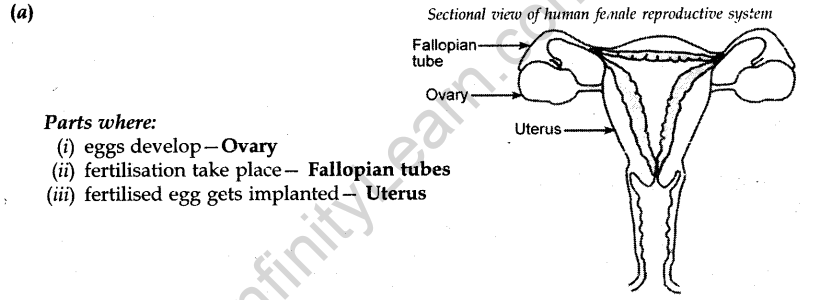
(b) (i) The inner lining of the uterus becomes thick and soft with lots of blood capillaries before release of a fertilised egg (zygote). The uterus has to keep this zygote for further development and supply it with food, oxygen, etc.
(ii) If no fertilization occurs then the thick uterus lining breaks down along with its bloods vessels in the form of vaginal bleeding called menstrual flow.
Question.21. (a) Name the parts labelled as A, B, C and D in the diagram given below:
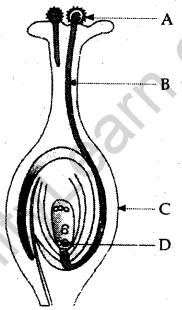
(b) What is pollination? State its significance.
(c) How does fertilisation occur in flowers? Name the parts of the flower that develop into (i) seed, and (ii) fruit after fertilisation.
Answer. (a) A — Pollen grains B — Pollen tube C — Ovary D — Ovule (ovum)
(b) The transfer of pollen grains from anther (male sexual part) of a flower to the stigma part of the pistil (female sexual part) is known as pollination.
Signification of pollination. It may be the cause of variation in a species of a plant.
(c) Fertilisation in flower. A pollen grain contains two male gametes. When a pollen grain falls on the stigma of the carpel, it grows a pollen tube downwards into the style. One of the male gametes reaches the ovary through pollen tube and fuses with female gamete present in the ovule. This fertilisation of the two germ cells forms a zygote. The zygote is capable of growing into a new plant.
The other male gamete fuses with two polar nuclei to form endosperm nucleus. This fusion is called triple fusion. The zygote grows into an embryo and an endosperm nucleus grows into endosperm (the food storage tissue of seed).
(i) All the eggs in the ovule present in the ovary of a flower gets fertilised by male gametes from pollen grains and grow to become seeds.
(ii) The ovary of flower develops and becomes fruit.
Question.22. Explain the following terms related to spherical lenses:
(i) optical center
(ii) centres of curvature
(iii) principal axis
(iv) aperture
(v) principal focus
(vi) focal length
(b) A converging lens has focal length of 12 cm. Calculate at what distance should the object be placed from the lens so that it forms an image at 48 cm on the other side of the lens.
Answer. (a) (i) Optical center. It is a point within the lens that lies on the principal axis through which a ray of light passes undeflected.
(ii) Centre of curvature. The centre of curvature of the surface of a lens is the centre of the sphere of which it forms a part. A lens has two centres of curvature because it has two surfaces.
(iii) Principal axis. It is a line through the centres of curvature of the lens.
(iv) Aperture. The diameter of the circular boundary of the lens is called the aperture of the lens.
(v) Principal focus. A beam of light parallel to the principal axis either converges to a point or appears to diverge from a point on the principal axis after refraction through the lens, is called the principal focus. All lenses have two principal focuses.
(vi) Focal length. The distance between the optical centre and the principal focus of the lens is called its focal length.
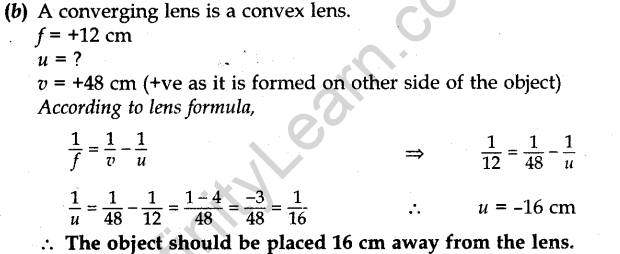
Question.23. (a) List the parts of the human eye that control the amount of light entering into it. Explain how they perform this function.
(b) Write the function of retina in human eye.
(c) Do you know that the corneal-impairment can be cured by replacing the defective cornea with the cornea of the donated eyes? How and why should we organise groups to motivate the community members to donate their eyes after death?
Answer. (a) The iris and pupil control the amount of light entering the eyes. If the amount of light received by the eye is large (as during the day time), then the iris contracts the pupil (makes the pupil small) and reduces the amount of light entering the eye.
If the amount of light received by the eye is small (as in a dark room or during night), the iris expands the pupil (makes the pupil large) so that more light may enter the eyes.
(b) The screen on which the image is formed in the eye is called retina. Retina is a delicate membrane having a large number of light sensitive cells called ‘rods’ and ‘cones’ which respond to the ‘intensity of light’ and ‘colours of object’ respectively.
(c) See Q. 23(c), 2013 (I Outside Delhi).
Question.24. (a) Why do we classify elements?
(b) What were the two criteria used by Mendeleev in creating his Periodic Table?
(c) Why did Mendeleev leave some gaps in his Periodic Table?
(d) In Mendeleev’s Periodic Table, why was there no mention of Noble gases like Helium, Neon and Argon?
(e) Would you place the two isotopes of chlorine, Cl-35 and Cl-37 in different slots because of their different atomic masses or in the same slot because their chemical properties are the same? Justify your answer.
Answer. (a) As different elements were being discovered, scientists gathered more information about the properties of these elements. It was observed that it was difficult to organise all the information or properties of these elements. So scientists started discovering some pattern in their properties to classify all the known elements to make their study easier.
(b) Atomic mass and similarity of chemical properties (compounds formed by elements with oxygen and hydrogen) were the two criteria used by Mendeleev in his Periodic Table.
(c) Mendeleev left some gaps in his Periodic Table as he predicted the existence of some elements that had not been discovered at that time.
(d) Noble gases like helium, neon, argon etc. were not mentioned in Mendeleev’s Periodic Table because these gases were discovered later as they are very inert and present in extremely low concentrations in our atmosphere. After the discovery of noble gases they could be placed in a new group without disturbing the existing order of the Periodic Table.
(f) The two isotopes of chlorine Cl-35 and CI-37 would be placed in different slots of Mendeleev’s Periodic Table as both have different atomic masses. But the two isotopes have same chemical properties so would also be placed in the same slot. This is a contradiction. Thus position of isotopes of an element is not defined in Mendeleev’s Periodic Table.
SECTION B
Question.25. In an experiment to study the properties of ethanoic acid, a student takes about 3 mL of ethanoic acid in a dry test tube. He adds an equal amount of distilled water to it and shakes the test tube well. After some time he is likely to observe that
(A) a colloid is formed in the test tube.
(B) the ethanoic acid dissolves readily in water.
(C) the solution becomes light orange.
(D) water floats over the surface of ethanoic acid.
Answer. (B)
Question.26. A student takes about 2 mL ethanoic acid in a dry test tube and adds a pinch of sodium hydrogen carbonate to it. He reports the following observations:
I. Immediately a colourless and odourless gas evolves with a brisk effervescence.
II. The gas turns lime water milky when passed through it.
III. The gas burns with an explosion when a burning splinter is brought near it.
IV. The gas extinguishes the burning splinter that is brought near it.
The correct observations are
(A) I, II and III (B) II, III arid IV (C) III, IV and I (D) I, II and IV
Answer. (D)
Question.27. In a locality, hard water, required for an experiment, is not available. However, the following salts are available in the school laboratory:
1. Sodium sulphate 2. Calcium sulphate
3. Magnesium chloride 4. Sodium chloride
5. Calcium chloride 6. Potassium sulphate
Which of the above salts may be dissolved in water to obtain hard water for the experiment?
(A) 2, 3 and 5 (B) 1, 2 and 5 (C) 1, 2, 4 and 6 (D) 3 and 5 only
Answer. (A)
Question.28. A student has obtained an image of a well-illuminated distant object on a screen to determine the focal length, F1 of the given spherical mirror. The teacher then gave him another mirror of focal length, F2 and asked him to obtain a focussed image of the same object on the same screen. The student found that in order to focus the same object using the second mirror, he has to move the mirror away from the screen. From this observation it may be concluded that both the spherical mirrors given to the student were (select the correct option)
(A) Concave and F1< F2 (B) Concave and F1> F2
(C) Convex and F1< F2 (D) Convex and F1 > F2
Answer. (A)
Question.29. After tracing the path of a ray of light passing through a rectangular glass slab for four different values of the angle of incidence, a student reported his observations in tabular form as given below:

The best observation is (A) I (B) II (C) III (D) IV
Answer. (C)
Question.30. Study the following diagrams in which the path of a ray of light passing through a glass prism as traced by four students P, Q, R and S is shown:

(A) P (B) Q (C) R (D) S
Answer. (B)
Question.31. When you study a slide showing different stages of budding in yeast, you observe the following stages:
I. The bud may get separated from the parent body and develop into a new individual.
II. The body of the bud .develops and gives rise to another baby bud.
III. A bud comes out in any direction from the body of the parent cell.
IV. Thus they may form a colony.
The proper sequence of the above stages is
(A) II, I, III, IV (B) II, III, I, IV (C) in, II, I, IV (D) III, I, II, IV .
Answer. (D)
Question.32. Study the following statements:
I. Wings of birds and wings of bats are homologous organs.
II. Wings of birds and wings of insects are modified forelimbs.
III. Wings of birds and wings of insects are analogous organs.
IV. Wings of birds and forelimbs of horse are homologous organs.
The correct statements are:
(A) I and II (B) II and III (C) III and IV (D) I and IV
Answer. (C)
Question.33. In the following diagram showing the structure of embryo of a dicot seed, what are the parts marked I, II and III sequentially?

(A) Plumule, Cotyledon, Radicle (B) Plumule/Radicle, Cotyledon
(C) Cotyledon, Plumule, Radicle (D) Radicle, Plumule, Cotyledon
Answer. (A)
Question.34. What happens when acetic acid is added in a solution of Na2C03 in a test tube. Write the equation for detecting the gas evolved.
Answer. CO2 gas is evolved with brisk bubbles in this reaction.
White ppt. are formed, when C02 gas is passed through the lime water.
![]()
Question.35. When a ray of light passes through a glass slab how many times does it change its path and why?
Answer. The ray of light bends twice. First time when it enters from air to the glass slab, it bends towards the normal, i.e., from rarer medium to denser medium.
Second time, when the ray moves out from the glass slab to air, it bends away from the normal, i.e., it moves from denser medium to rarer medium.
Question.36. Why do raisins absorb water when soaked in water? Explain the phenomenon.
Answer. Raisins absorb water due to the process of endosmosis. Water moves from semi permeable membrane of raisins into the raisin, i.e., from hypotonic solution to the hypertonic solution of raisin cell sap.
SET II
Except for the following questions, all the remaining questions have been asked in Set-l.
SECTION A
Question.1. Write the atomic numbers of two elements ‘X and ‘Y having electronic configuration
Answer.

Question.2. What is heredity?
Answer. The transmission of characters from the parents to their offspring is called heredity.
Question.3. List two items which can be easily recycled, but we generally throw them in the dustbins.
Answer. Two items which can be easily recycled:
- Broken plastic containers
- Broken metal pipe
Question.4. “The chromosomal number of the sexually producing parents and their offspring is the same.” Justify this statement.
Answer. During the formation of sex gamete cells in the parents, the number of chromosomes are reduced to half in these cells. As these cells combine (fuse) to form the offspring, the number of chromosomes in the offspring becomes equal to parents’ number.
Question.5. The image formed by a concave mirror is observed to be virtual, erect and larger than the object. Where should the position of the object be relative to the mirror? Draw ray diagram to justify your answer.
Answer. When the object is placed between pole and focus of the concave mirror, the image formed is virtual, erect and magnified.

Question.6. List two reasons to show that the existence of decomposers is essential in an ecosystem.
Answer. Role of decomposers:
- Decomposers naturally replenish the nutrients in the soil, air and water.
- Decomposers help in keeping the environment clean. They play an important role in the cycling of materials in the biosphere.
Question.10. A student wants to project the image of a candle flame on a screen 48 cm in front of a mirror by keeping the flame at a distance of 12 cm from its pole.
(a) Suggest the type of mirror he should use.
(b) Find the linear magnification of the image produced.
(c) How far is the image from its object?
(d) Draw ray diagram to show the image formation in this case.
Answer.
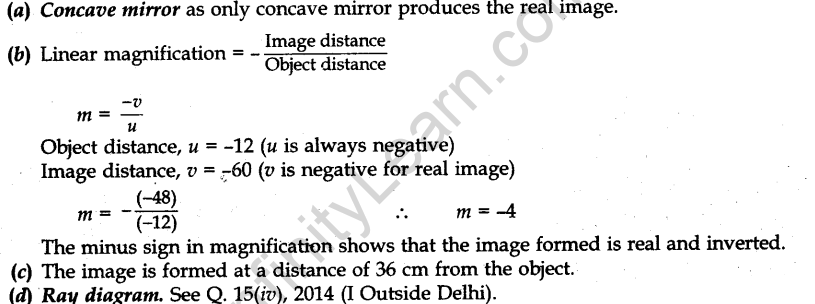
Question.13. What is meant by homologous series of carbon compounds? Write the general formula of (i) alkenes, and (ii) alkynes. Draw the structures of the first member of each series to show the bonding between the two carbon atoms.
Answer.

Question.15. What is meant by ‘group’ in the modem periodic table? How do the following change on moving from top to bottom in a group?
(i) Number of valence electrons
(ii) Number of occupied shells
(iii) Size of atoms
(iv) Metallic character of elements
(v) Effective nuclear change experienced by valence electrons
Answer. The vertical columns in a periodic table are called groups.
(i) All the elements of a group have the same number of valence electrons.
(ii) On moving down in a group the number of occupied (filled) shells increases gradually,
(iii) On going down in a group the size of atoms increases because a new shell of electrons is added to the atoms at every step.
(iv) On going down in a group the metallic character of elements increases.
(v) On moving down in a group, one more electron shell is added at every stage and size of the atom increases. Thus valence electrons move more and more away from the nucleus and hold of the nucleus or nuclear charge on valence electrons decreases.
Question.17. List four methods of contraception used by humans.
Justify the following statement:
“The use of contraceptive methods has a direct effect on the health and prosperity of a family.”
Answer. See Q. 12, 2014 (I Delhi).
Question.18. “It is a matter of chance whether a couple will give birth to a male child or a female child.” Justify this statement with the help of a flow chart showing the fusion of sex chromosomes.
Answer. See Q. 14, 2012 (II Outside Delhi).
SET III
Except for the following questions, all the remaining questions have been asked in Set-I and Set-II.
SECTION A
Question.1. The atomic numbers of three elements A, B and C are 12,18 and 20 respectively. State, giving reason, which two elements will show similar properties.
Answer.

Elements A and C will show similar properties as both have same number of valence elements.
Question.2. No two individuals are absolutely alike in a population. Why?
Answer. DNA copying is an essential part of the process of reproduction for the inheritance of features from parents to the next generation. The process of DNA copying brings some variation each time. The surviving cells are similar to but subtly different from each other. This in built tendency for variation during reproduction brings variations among individuals of the same species. Thus, no two individuals are absolutely alike in a population.
Question.3. Write one negative effect of affluent lifestyle of few persons on the environment.
Answer. Affluent lifestyle increases the consumption of various natural resources. For example, if every member of family has his own vehicle then the consumption of fuel (petrol, diesel) increases. Exploitation and over- consumption of resources in this manner will lead to their scarcity.
Question.4. Draw labelled diagrams to illustrate budding in Hydra.
Answer. See Q. 20, 2011 (I Outside Delhi).
Question.5. “A concave mirror of focal length 15 cm can form a magnified erect as well as inverted image of an object placed in front of it.” Justify this statement stating the position of the object with respect to the pole of the mirror in both cases for obtaining the images.
Answer. Case 1. When the object is placed between less than 15 cm from the pole, i.e., between the pole and the focus of a concave mirror, a magnified, erect and virtual image will be formed.
Case 2. When the object is placed between 15 to 30 cm, i.e., between the focus and the centre of curvature of the concave mirror, a magnified, inverted and real image will be formed.
Question.6. State with reason any two possible consequences of elimination of decomposers from the Earth.
Answer. If there were no decomposers, then the dead bodies of plants and animals would keep lying as such and the elements of which plant and animals bodies are made, would never be returned to their original pools like soil, air and water. In that case, the cycling process of life and death would be disrupted. All the nutrients present in soil, air and water would soon be exhausted and evolution of life would come to an end.
Question.9. The elements Be, Mg and Ca each having two electrons in their outermost shells are in periods 2, 3, and 4 respectively of the modern periodic table. Answer the following questions, giving justification in each case:
(i) Write the group to which these elements belong.
(i) Name of the least reactive element.
(iii) Name the element having largest atomic radius.
Answer.

(i) All these elements belong to the 2nd group as all have two electrons in their outermost shell.
(ii) Be is the least reactive metal because reactivity of metals increases in a period as the tendency to lose electrons in a group increases.
Therefore Be being the smallest in all the given elements of a period has its valence electrons nearest to the nucleus. So the removal of electrons from its valence shell will be difficult.
(iii) Ca has the largest atomic radius because it has maximum number of shells, i.e., 4.
Question.11. Define the term ‘structural isomerism’. Explain why propane cannot exhibit this property. Draw the structures of possible isomers of butane, C 4H 10.
Answer. (i) The organic compounds having the same molecular formula but different structures are known as structural isomers.
(ii) The phenomenon of occurring two or more different organic compounds having the same molecular formula but different structures is called ‘structural isomerism’.
(iii) No isomerism is possible in propane as it has only 3 carbon atoms, it is not possible to have different arrangement of carbon atoms in propane.
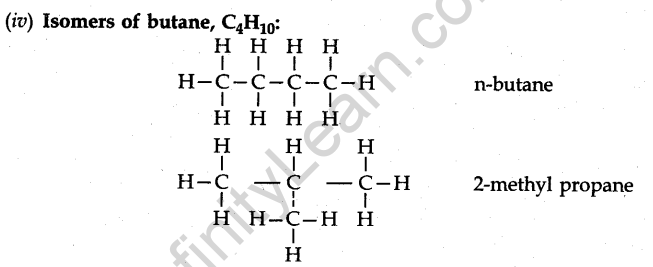
Question.12. A student wants to project the image of a candle flame on a screen 90 cm in front of a mirror by keeping the flame at a distance of 15 cm from its pole.
(a) Suggest the type of mirror he should use.
(b) Determine the liner magnification in this case.
(c) Find the distance between the object and its image.
(d) Draw ray diagram to show the image formation in this case.
Answer.
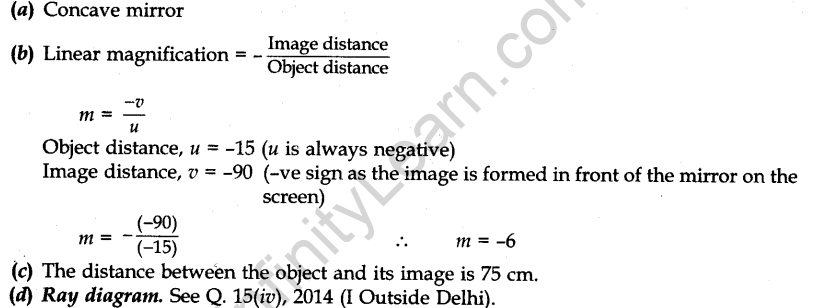
Question.16. Write one difference between asexual and sexual mode of reproduction. Which species is likely to have better chances of survival—the one reproducing asexually or the one reproducing sexually? Justify your answer.
Answer.
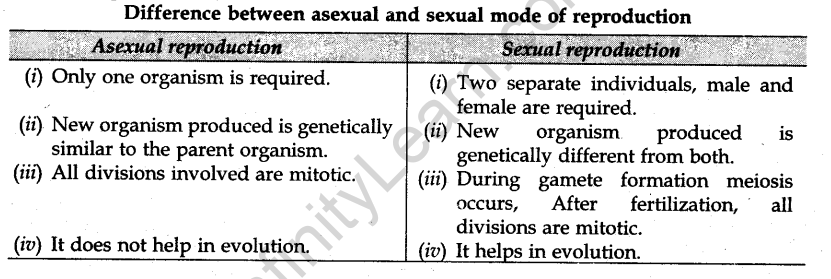
The survival of animal reproducing sexually has better chance of survival:
(i) Modes of sexual reproduction allow for greater variations to be generated which are useful for ensuring the survival of the individuals of species during the struggle for existence. Sexually reproductive young ones are more healthy than those reproduced by asexual methods.
(ii) In asexual reproduction, the off springs are almost identical to their parent because they have the same genes as their parent, so much genetic variation is not possible in asexual reproduction. This is a disadvantage because it inhibits the further evolution of the organism.
Question.17. What is the effect of DNA copying, which is not perfectly accurate, on the reproduction process? How does the amount of DNA remain constant though each new generation is a combination of DNA copies of two individuals?
Answer. DNA coping is not perfectly accurate. During reproduction, no bio-chemical reaction is absolutely reliable so the process of copying the DNA will have some variations each time. As a result, the DNA copies generated will be similar but may not be identical to the original. Thus the surviving new born cells are similar to but subtly different from each other. This inbuilt tendency for variation during reproduction is the basic for evolution. DNA remains constant. The DNA in the cell nucleus is the information source for making proteins.
The basic event in reproduction is the creation of a DNA copy. Cells use chemical reactions to build copies of their DNA. This creates two copies of the DNA in a reproducing cell, and they will need to be separated from each other. DNA copying occurs accompanied by the creation of an additional cellular apparatus. The DNA copies then separate, each having its own cellular apparatus for maintaining life processes.
Question.18. List three main factors responsible for the speciation and briefly describe each one of them.
Answer. See Q. 17, 2012 (I Delhi).
Question.20. List two reasons for carbon forming a large number of compounds. Name the type of bonding found in most of its compounds. Why does carbon form compounds mainly by this kind of bonding?
Give reason why the carbon compounds
(i) generally have low melting and boiling points.
(ii) do not conduct electricity in molten state.
Answer. Carbon forms a large number of compounds.
The two properties of carbon which lead to the huge number of carbon compounds are:
— Catenation. Catenation is the unique property of carbon atoms to form bonds with other atoms of carbon giving rise to large molecules.
— Tetravalency. Since carbon has a valency of four, it is capable of bonding with four other atoms of carbon or atoms of some other monovalent elements.
Carbon compounds are formed mainly by covalent bonding, i.e., bond formed by sharing of electrons because Carbon atoms have 4 electrons in their outermost shell. So needs to gain or lose electrons to attain noble gas configuration. It could gain four electrons forming C4- anion. But it would be difficult for the nucleus with six protons to hold on to ten electrons. It could lose four electrons forming C4+ cation. But it would require a large amount of energy to remove four electrons from its outermost shell.
Because of these reasons, carbon shares its valence electrons to complete its octet with other atoms to form covalent bonds.
Carbon compounds generally have low melting and boiling points because carbon compounds are generally formed by covalent bonds in which the force of attraction between their molecules is not very strong. Carbon compounds do not conduct electricity. As carbon compounds have covalent bonds between them, these do not give rise to any ions in their solution form or molten state. So carbon compounds do not conduct electricity through them.



